In Situ Monitoring and Analysis of the Development Characteristics of Separation in Internal Overburden
Abstract
:1. Introduction
2. The General Situation of the Working Face
3. In Situ Monitoring Program
3.1. Principle of Monitoring
3.2. On-Site Implementation
4. The Estimated Height of Overburden Water-Conducting Fracture Zone
5. In Situ Monitoring Result
5.1. DOFS Data
5.2. MPBXs Data
6. Discussion
6.1. Separation Layer Analysis Based on the Micro-Strain of DOFS
6.2. Separation Layer Analysis Based on Displacement Data of MPBXs
7. Conclusions
- (1)
- The development height of the water-conducting fracture zone in the LC1 borehole was predicted first. As has been predicted, the development height would be 173.95 m, 12.4~16.7 times of the mining height. Meanwhile, the top boundary height of the water-conducting fracture zone is predicted to be located near KS4 in the upper section of the Anting Formation.
- (2)
- The deformation position monitored inside the LC1 borehole was compared with the changing curve of the water level in the No. 6 drainage hole. Based on the corresponding variation characteristics of deformation and water level data, it can be inferred that the top boundary height of the water-conducting fracture zone is located near KS4 at a distance of 186.1~207.9 m above the roof of the coal seam.
- (3)
- As is shown by the breakage characteristics of DOFS inside the LC1 borehole, a relatively large tensile strain appears at the borehole depths of 351.3 m and 390.4 m. Accordingly, it can be inferred that the separation layer appears near the middle section of Lo-ho Formation.
- (4)
- According to the displacement data obtained through the MPBXs inside the LC1 borehole, the largest displacement difference appears between the 5#MPBX at a depth of 388 m and the 6#MPBX at a depth of 324 m inside the LC1 borehole. This indicates that the subsidence deformation between the two corresponding overlying strata in the borehole is not synchronized. In other words, the largest development of the separation layer is located within the middle section of the Lo-ho Formation (between the depths of 388 m and 324 m).
- (5)
- Combined with the strain data of DOFS, displacement data obtained from MPBXs, and water level data, the height of the water-conducting fracture zone was mutually verified with the development of a separation layer in the overlying strata. The results obtained are in line with in situ monitoring data, which provides reliable guidance for the on-site control of hazards caused by separation seepers.
Author Contributions
Funding
Institutional Review Board Statement
Informed Consent Statement
Data Availability Statement
Acknowledgments
Conflicts of Interest
References
- Cao, D.T. Water inrush of hydrostatic pressure in separated layer and its control. Hydrogeol. Eng. Geol. 2013, 40, 9–12. [Google Scholar]
- Qiao, W.; Li, W.P.; Li, X.Q. Mechanism and prevention of “hydrostatic water inrush” of roof separation water in stope. J. Min. Safety. Eng. 2011, 28, 96–104. [Google Scholar]
- Xu, J.L.; Qian, M.G.; Jin, H.W. Study and application of bed separation distribution and development in the process of strata movement. Chin. J. Geotech. Eng. 2004, 24, 632–636. [Google Scholar]
- Ji, Y.D.; Cao, H.D.; Zhao, B.F. Mechanism and control of water inrush from separated roof layers in the jurassic coalfields. Mine Water Environ. 2021, 40, 357–365. [Google Scholar] [CrossRef]
- Li, H.J.; Chen, Q.T.; Shu, Z.Y.; Li, L.; Zhang, Y.C. On prevention and mechanism of bed separation water inrush for thick coal seams: A case study in China. Environ. Earth Sci. 2018, 77, 759. [Google Scholar] [CrossRef]
- Gandhe, A.; Venkateswarlu, V.; Gupta, R.N. Extraction of coal under a surface water body–a strata control investigation. Rock. Mech. Rock. Eng. 2005, 38, 399–410. [Google Scholar] [CrossRef]
- Holla, L. Ground movement due to longwall mining in high relief areas in New South Wales, Australia. Int. J. Rock. Mech. Min. Sci. 1997, 34, 775–787. [Google Scholar] [CrossRef]
- Wu, Q.; Liu, Y.; Zhou, W.; Li, B.; Zhao, B.; Liu, S.; Sun, W.; Zeng, Y. Evaluation of water inrush vulnerability from aquifers overlying coal seams in the Menkeqing Coal Mine, China. Mine Water Environ. 2015, 34, 258–269. [Google Scholar] [CrossRef]
- Heather, E.L.; Douglas, T.; Mark, K.L.; Habte, A. Effects of overburden characteristics on dynamic failure in underground coal mining. Int. J. Min. Sci. Tech. 2017, 27, 121–129. [Google Scholar]
- Ma, L.J.; Zhao, B.F.; Wang, H.; Gao, Y. Analysis of spatial differences in permeability based on sedimentary and structural features of the sandstone aquifer overlying coal seams in western China. Mine Water Environ. 2020, 39, 229–241. [Google Scholar] [CrossRef]
- He, J.H.; Li, W.P.; Qiao, W.; Yang, Z.; Wang, Q.Q. Risk assessment of water inrushes from bed separations in Cretaceous strata corresponding to different excavation lengths during mining in the Ordos Basin. Geomat. Nat. Haz. Risk. 2021, 12, 2300–2327. [Google Scholar] [CrossRef]
- Palchik, V. Formation of fractured zones in overburden due to longwall mining. Env. Geol. 2003, 44, 28–38. [Google Scholar] [CrossRef]
- Palchik, V. Localization of mining-induced horizontal fractures along rock layer interfaces in overburden: Field measurements and prediction. Env. Geol. 2005, 48, 68–80. [Google Scholar] [CrossRef]
- Gui, H.; Lin, M.; Song, X. Identification and application of roof bed separation (water) in coal mines. Mine Water Environ. 2019, 37, 376–384. [Google Scholar] [CrossRef]
- Sun, W.J.; Zhou, W.F.; Jiao, J. Hydrogeological Classification and Water Inrush Accidents in China’s Coal Mines. Mine Water Environ. 2016, 35, 214–220. [Google Scholar] [CrossRef]
- Xuan, D.Y.; Xu, J.L. Grout injection into bed separation to control surface subsidence during longwall mining under villages: Case study of Liudian coal mine. Nat. Haz. 2014, 73, 883–906. [Google Scholar] [CrossRef]
- Zhu, W.B.; Wang, X.Z.; Xu, J.L.; Liu, W.T. Study of mechanism of stope water inrush caused by water accumulation in overburden separation areas. Chin. J. Rock Mech. Eng. 2009, 28, 306–311. [Google Scholar]
- Abbas, M.; Ferri, P.H.; Mehdi, Y.N. Prediction of the height of destressed zone above the mined panel roof in longwall coal mining. Int. J. Coal Geol. 2012, 98, 62–72. [Google Scholar]
- Du, W.G.; Chai, J.; Zhang, D.D.; Lei, W.L. The study of water-resistant key strata stability detected by optic fiber sensing in shallow-buried coal seam. Int. J. Rock Mech. Min. Sci. 2021, 141, 104604. [Google Scholar] [CrossRef]
- Tan, Y.L.; Yu, F.H.; Chen, L. A new approach for predicting bedding separation of roof strata in underground coalmines. Int. J. Rock Mech. Min. Sci. 2013, 61, 183–188. [Google Scholar] [CrossRef]
- Sun, J.; Hu, Y.; Zhao, G.M. Relationship between water inrush from coal seam floors and main roof weighting. Int. J. Min. Sci. Tech. 2017, 27, 873–881. [Google Scholar] [CrossRef]
- Xu, J.L.; Zhu, W.B.; Wang, X.Z. New method to predict the height of fractured water-conducting zone by location of key strata. J. Chin. Coal Soc. 2012, 37, 762–769. [Google Scholar]
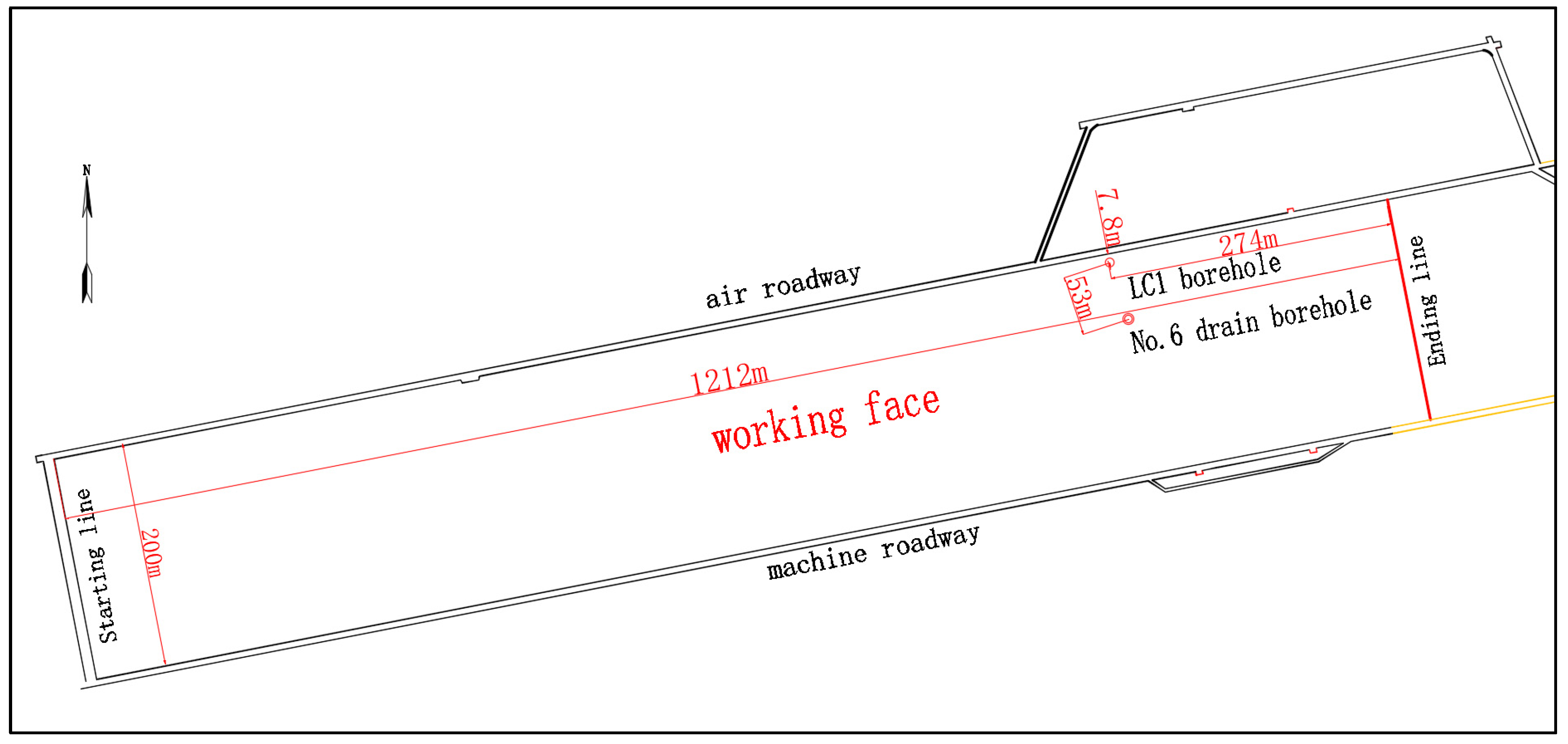
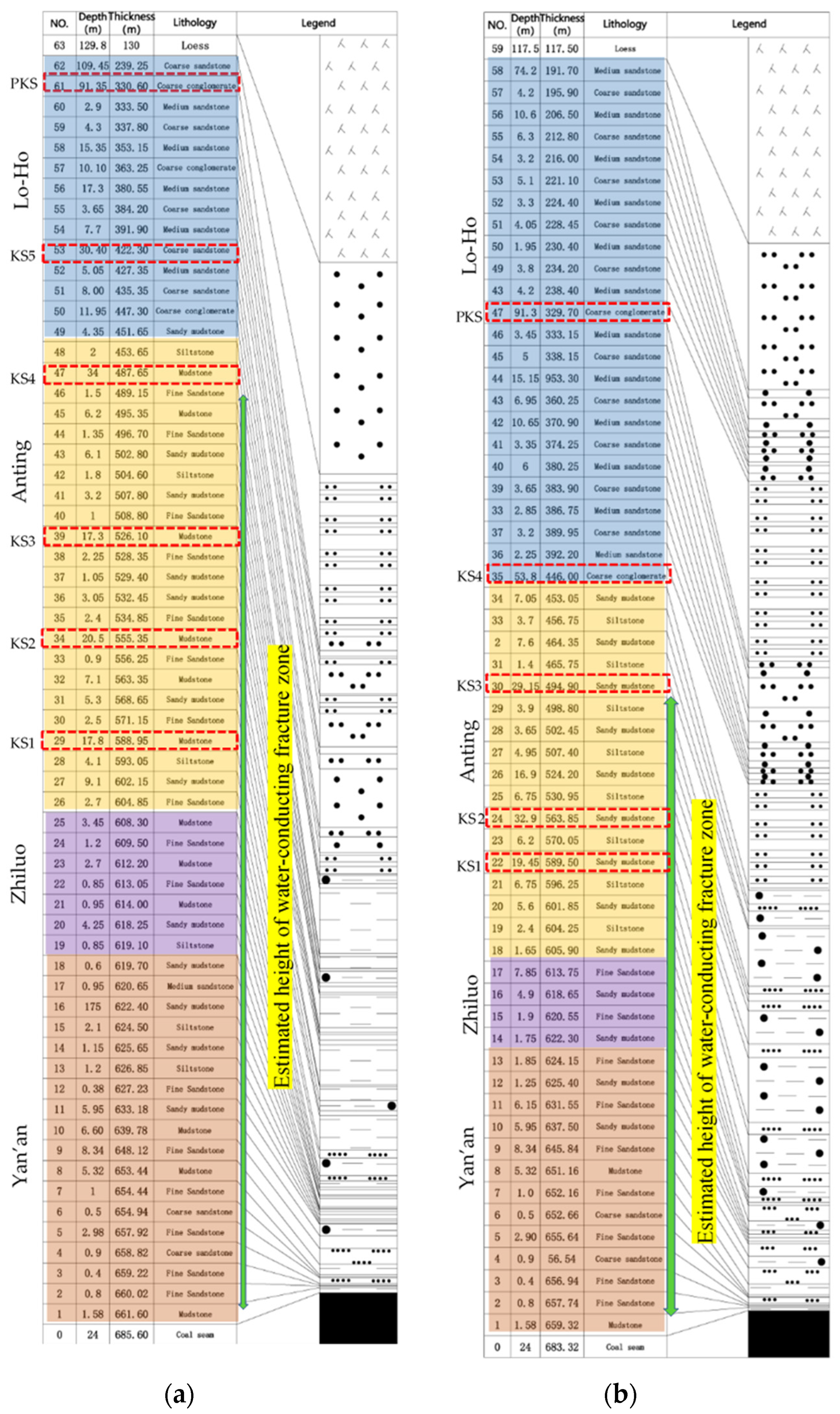


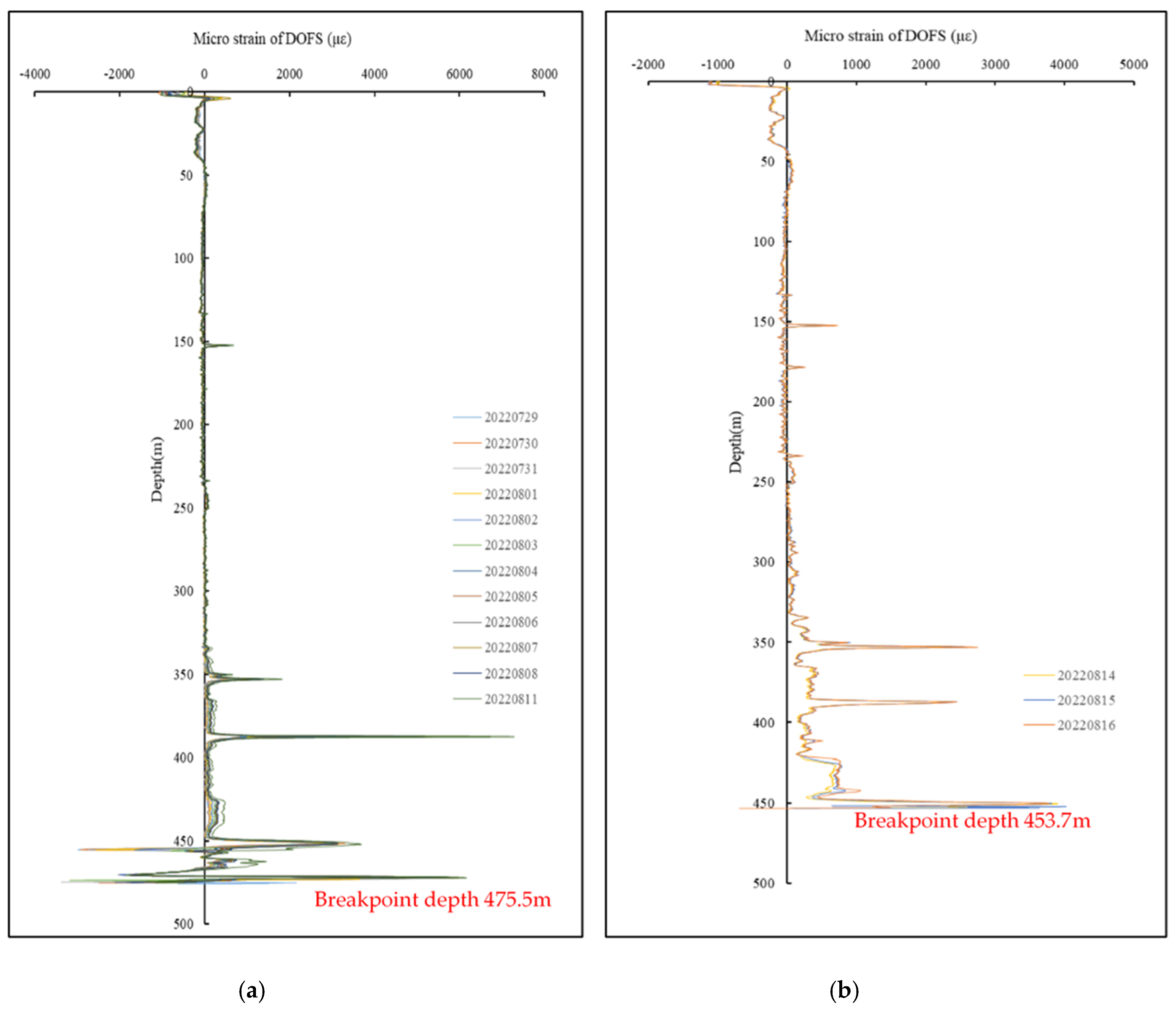
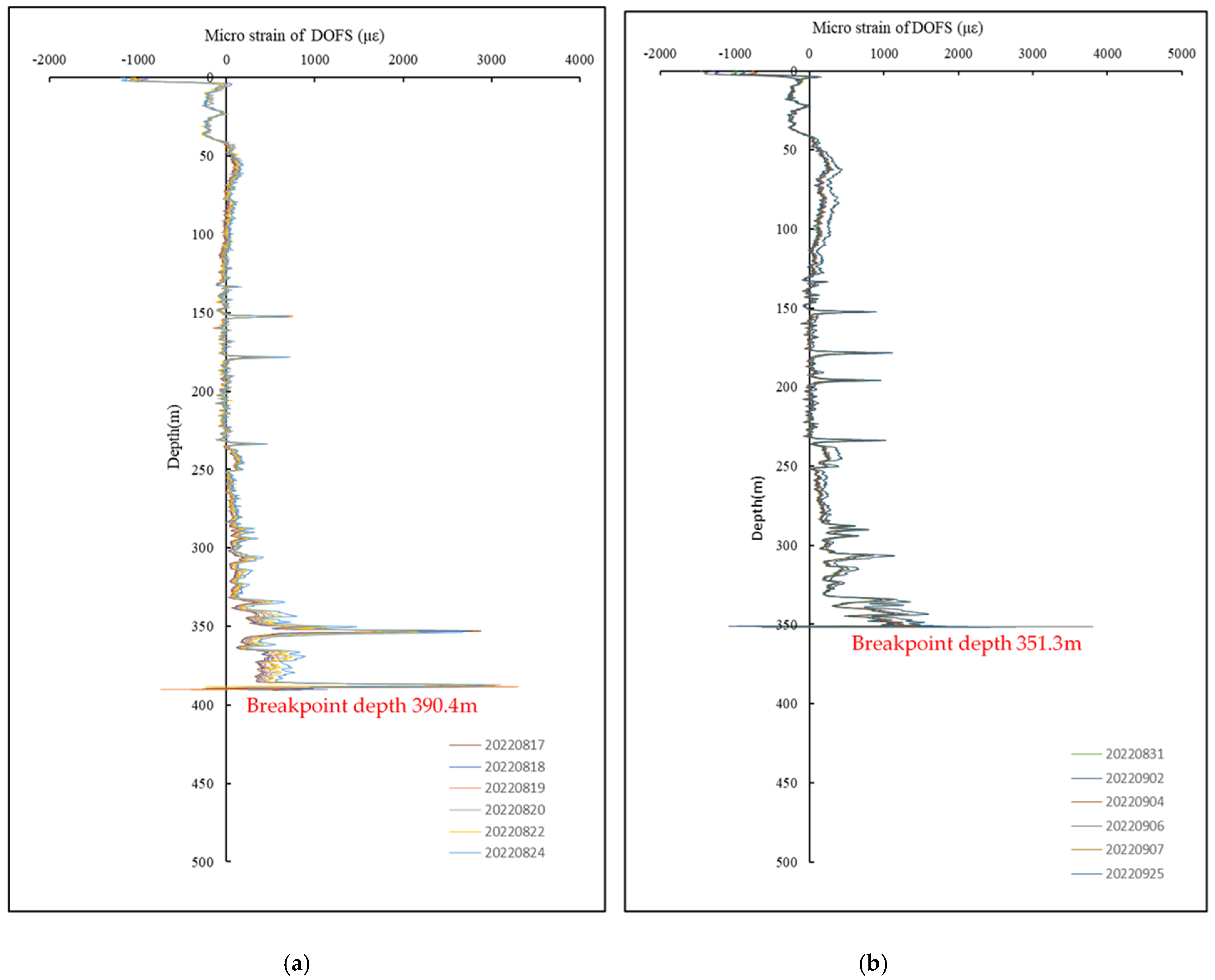
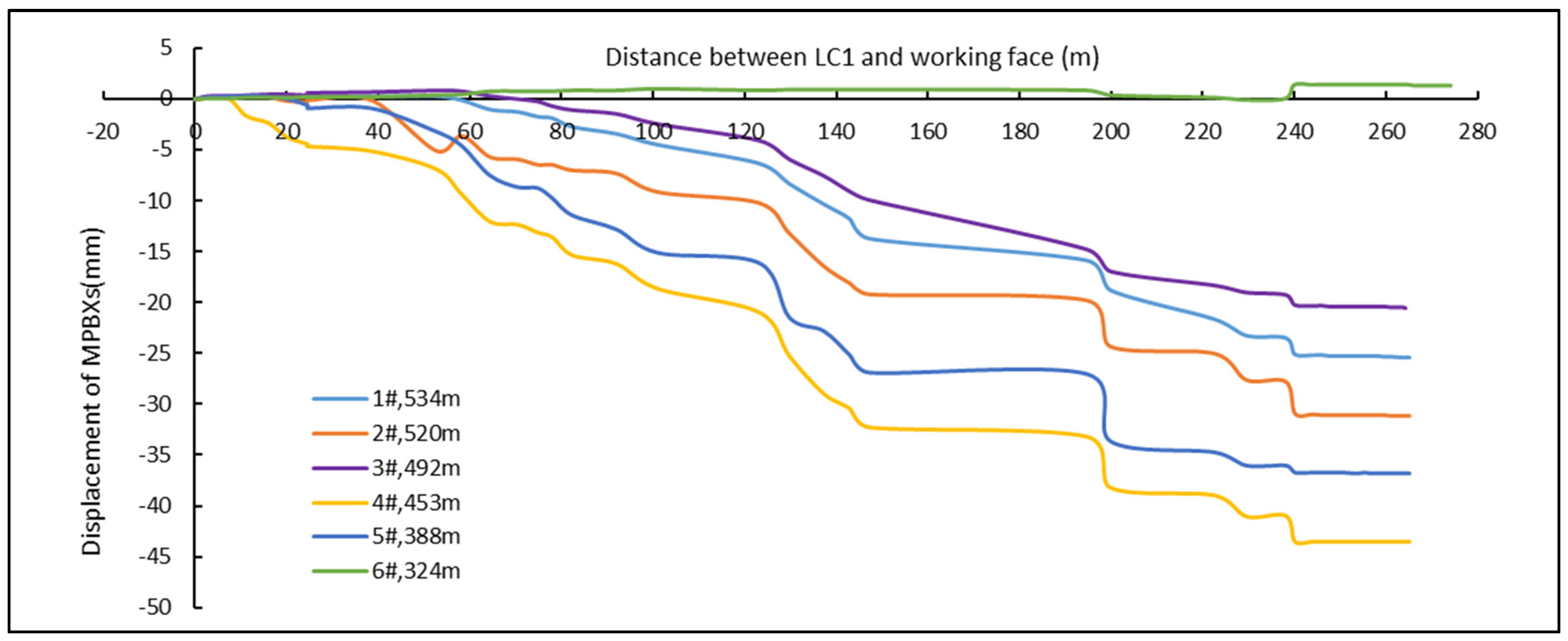
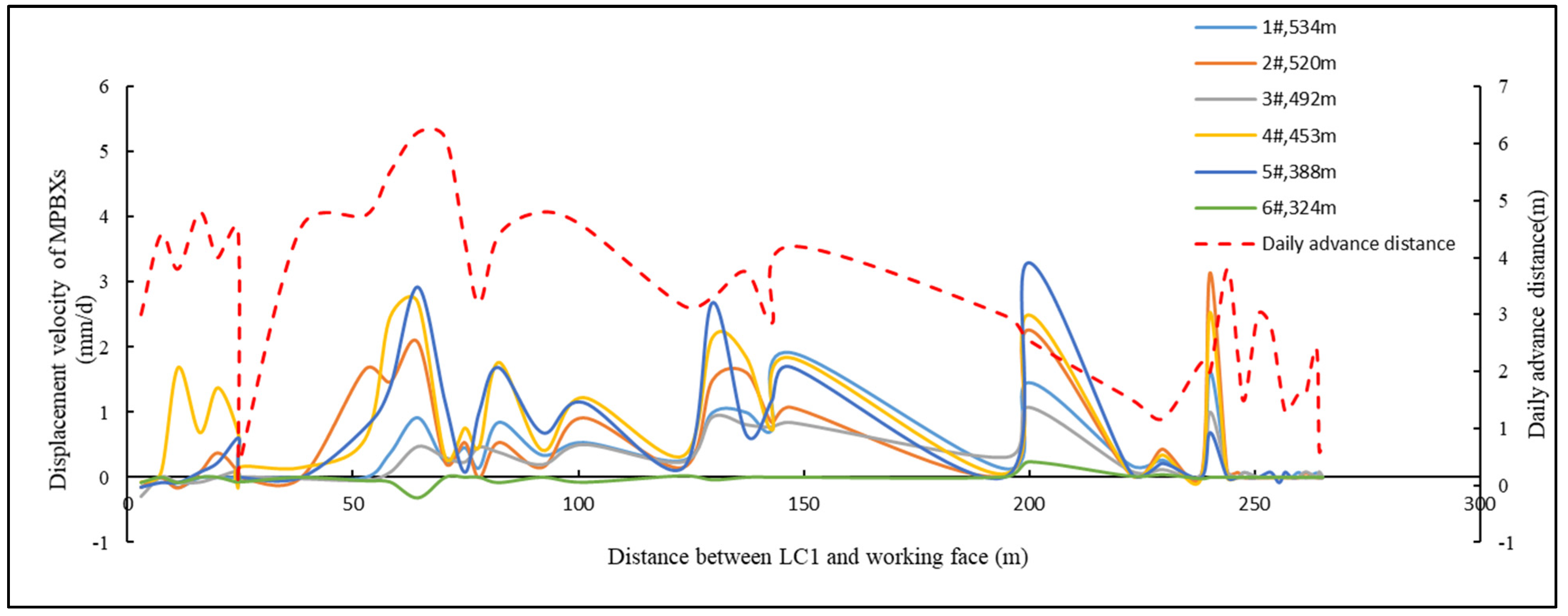


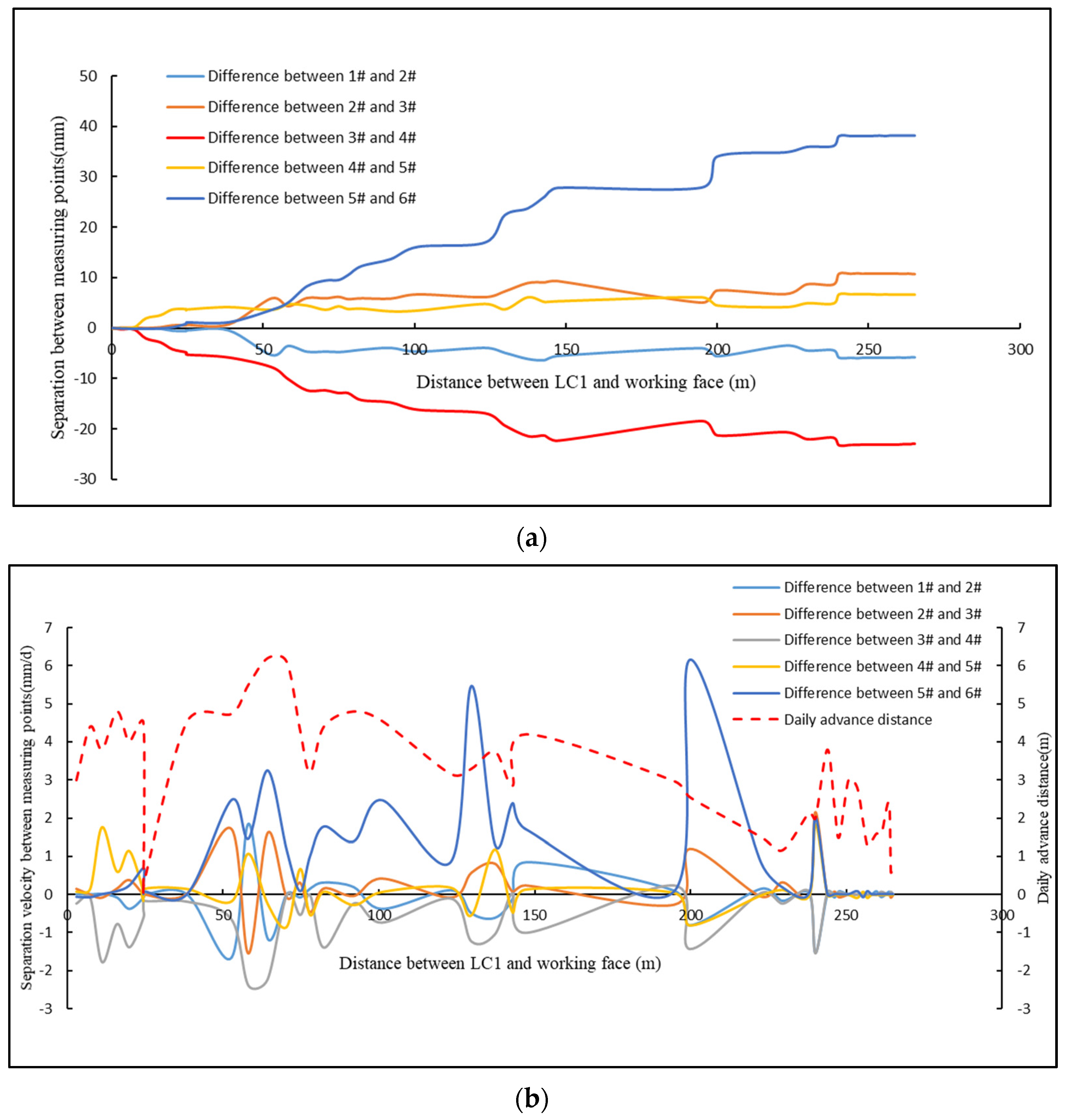

Disclaimer/Publisher’s Note: The statements, opinions and data contained in all publications are solely those of the individual author(s) and contributor(s) and not of MDPI and/or the editor(s). MDPI and/or the editor(s) disclaim responsibility for any injury to people or property resulting from any ideas, methods, instructions or products referred to in the content. |
© 2024 by the authors. Licensee MDPI, Basel, Switzerland. This article is an open access article distributed under the terms and conditions of the Creative Commons Attribution (CC BY) license (https://creativecommons.org/licenses/by/4.0/).
Share and Cite
Xie, J.; Wang, X.; Qiao, W. In Situ Monitoring and Analysis of the Development Characteristics of Separation in Internal Overburden. Appl. Sci. 2024, 14, 6935. https://doi.org/10.3390/app14166935
Xie J, Wang X, Qiao W. In Situ Monitoring and Analysis of the Development Characteristics of Separation in Internal Overburden. Applied Sciences. 2024; 14(16):6935. https://doi.org/10.3390/app14166935
Chicago/Turabian StyleXie, Jianlin, Xiaozhen Wang, and Wei Qiao. 2024. "In Situ Monitoring and Analysis of the Development Characteristics of Separation in Internal Overburden" Applied Sciences 14, no. 16: 6935. https://doi.org/10.3390/app14166935




